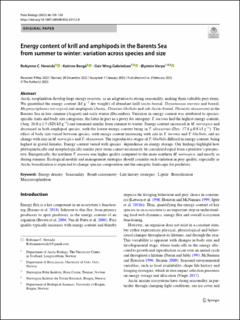| dc.contributor.author | Nowicki, Robynne | |
| dc.contributor.author | Borgå, Katrine | |
| dc.contributor.author | Gabrielsen, Geir W. | |
| dc.contributor.author | Varpe, Øystein | |
| dc.date.accessioned | 2023-08-09T07:27:05Z | |
| dc.date.available | 2023-08-09T07:27:05Z | |
| dc.date.created | 2023-02-23T12:34:51Z | |
| dc.date.issued | 2023 | |
| dc.identifier.issn | 0722-4060 | |
| dc.identifier.uri | https://hdl.handle.net/11250/3083120 | |
| dc.description.abstract | Arctic zooplankton develop large energy reserves, as an adaptation to strong seasonality, making them valuable prey items. We quantified the energy content (kJ g−1 dry weight) of abundant krill (arcto-boreal, Thysanoessa inermis and boreal, Meganyctiphanes norvegica) and amphipods (Arctic, Themisto libellula and sub-Arctic-boreal, Themisto abyssorum) in the Barents Sea in late summer (August) and early winter (December). Variation in energy content was attributed to species-specific traits and body size categories, the latter in part as a proxy for ontogeny. T. inermis had the highest energy content, (Aug: 26.8 ± 1.5 (SD) kJ g−1) and remained similar from summer to winter. Energy content increased in M. norvegica and decreased in both amphipod species, with the lowest energy content being in T. abyssorum (Dec: 17.8 ± 0.8 kJ g−1). The effect of body size varied between species, with energy content increasing with size in T. inermis and T. libellula, and no change with size in M. norvegica and T. abyssorum. The reproductive stages of T. libellula differed in energy content, being highest in gravid females. Energy content varied with species’ dependence on energy storage. Our findings highlight how phylogenetically and morphologically similar prey items cannot necessarily be considered equal from a predator´s perspective. Energetically, the northern T. inermis was higher quality compared to the more southern M. norvegica, and mostly so during summer. Ecological models and management strategies should consider such variation in prey quality, especially as Arctic borealization is expected to change species composition and the energetic landscape for predators. | en_US |
| dc.language.iso | eng | en_US |
| dc.publisher | Springer | en_US |
| dc.rights | Navngivelse 4.0 Internasjonal | * |
| dc.rights.uri | http://creativecommons.org/licenses/by/4.0/deed.no | * |
| dc.title | Energy content of krill and amphipods in the Barents Sea from summer to winter: variation across species and size | en_US |
| dc.type | Journal article | en_US |
| dc.type | Peer reviewed | en_US |
| dc.description.version | publishedVersion | en_US |
| dc.rights.holder | Copyright 2023 the authors | en_US |
| cristin.ispublished | true | |
| cristin.fulltext | original | |
| cristin.qualitycode | 1 | |
| dc.identifier.doi | 10.1007/s00300-023-03112-0 | |
| dc.identifier.cristin | 2128551 | |
| dc.source.journal | Polar Biology | en_US |
| dc.source.pagenumber | 139-150 | en_US |
| dc.relation.project | Norges forskningsråd: 276730 | en_US |
| dc.identifier.citation | Polar Biology. 2023, 46, 139-150. | en_US |
| dc.source.volume | 46 | en_US |

